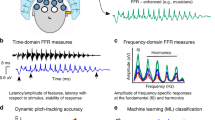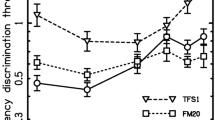Abstract
Mr. ACKERMANN (NATURE, May 20, p. 649) is probably correct when he states that the first incoming sound wave sets all the resonators of the ear temporarily in vibration, and also, that as the sound waves continue the vibrating resonators decrease in number until only those are left in motion that are executing either sympathetic or forced vibration in time with the incoming sound waves. But surely he has left out of account the probable amplitude of the motion performed by the resonators, and the probable physiological properties of the mechanism, when he judges the intensity of the sound stimuli sent along the auditory nerve to the brain to be directly proportional to the number of resonators that are swinging at any moment?
This is a preview of subscription content, access via your institution
Access options
Subscribe to this journal
Receive 51 print issues and online access
$199.00 per year
only $3.90 per issue
Buy this article
- Purchase on Springer Link
- Instant access to full article PDF
Prices may be subject to local taxes which are calculated during checkout
Similar content being viewed by others
Author information
Authors and Affiliations
Rights and permissions
About this article
Cite this article
HARTRIDGE, H. The Resonance Theory of Hearing. Nature 110, 9–10 (1922). https://doi.org/10.1038/110009b0
Issue Date:
DOI: https://doi.org/10.1038/110009b0
Comments
By submitting a comment you agree to abide by our Terms and Community Guidelines. If you find something abusive or that does not comply with our terms or guidelines please flag it as inappropriate.



